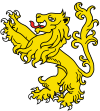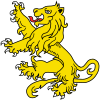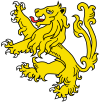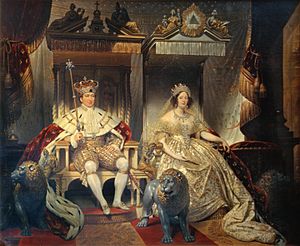Lions in heraldry facts for kids
Lions are super popular in heraldry, which is the study of coats of arms and symbols. In fact, they appear more often than any other animal! Lions traditionally stand for things like bravery, strength, and royalty.
You can find lions on a shield (called a "charge") or as a crest (a symbol often placed above the shield). When describing a lion in heraldry, people use special terms. They talk about its tincture (which means its color) and its attitude (which means its position). This description is called a blazon.
Sometimes, a lion's teeth and claws might be a different color from its body. When this happens, it's called "armed" with that color. For example, "A lion Or armed gules" means a gold lion with red teeth and claws. Even the tail can be described if it's in a special position!
Lions are shown in many different ways because lots of people wanted a lion on their coat of arms when heraldry first started. But no two coats of arms can be exactly the same! In the Middle Ages, coats of arms helped identify knights in their armour. So, to make each lion unique, artists drew them in many positions and colors. In some places like France and Germany, they even painted patterns on the lions.
In France, lions that are walking are sometimes called leopards. However, this term isn't used much by people who study British heraldry.
Contents
Lion Attitudes: Different Poses of Heraldic Lions
Even though there are many ways to show lions in heraldry today, medieval artists mostly drew them to simply fill the space on a shield. Here are some of the common positions, or attitudes, of heraldic lions:
| Attitude | Example | What it Means |
|---|---|---|
| Rampant |  |
A "lion rampant" is standing upright on its hind legs, with its front paws raised. It looks like it's ready to strike! This is the most common position for lions and other hunting animals in heraldry.
Note: The word segreant means the same pose, but it's only used for winged creatures like griffins and dragons. |
| Passant |  |
A "lion passant" is walking. Its right front paw is raised, and its other three paws are on the ground. The famous "Lion of England" is a lion passant guardant Or, which means a gold walking lion looking at you.
Note: Sometimes, a lion passant might be called a "leopard." |
| Statant |  |
A "lion statant" is standing still with all four feet on the ground. Its front paws are usually together. You often see lions in this position as crests (symbols above the shield) rather than on the shield itself. |
| Salient |  |
A "lion salient" is leaping or jumping. Both its hind legs are together on the ground, and both its front legs are together in the air. This is a very rare position for a lion, but other heraldic animals can be shown this way. |
| Sejant |  |
A "lion sejant" is sitting down on its back legs (haunches), with both front paws on the ground. |
| Sejant erect |  |
A "lion sejant erect" is sitting on its back legs, but its body is upright, and both front paws are raised like a "rampant" lion. This pose is sometimes called "sejant-rampant." |
| Couchant |  |
A "lion couchant" is lying down, but its head is raised. |
| Dormant |  |
A "lion dormant" is lying down with its eyes closed and head lowered, resting on its front paws. It looks like it's asleep. |
Other special words describe more details about the lion's position. Usually, a lion's head faces the same direction as its body (to the left), unless it says otherwise.
- If a lion's whole body is turned to face right, it's called to sinister or contourné.
- If its whole body faces you, it's affronté.
- If only its head faces you, it's guardant or gardant.
- If it looks back over its shoulder (body facing left, head facing right), it's regardant.
These words come after the main description of the lion's position. Then, the lion might be described as armed (meaning its teeth and claws are a different color). Finally, its tail might be described if it's unusual.
- A lion (or other animal) that is coward has its tail between its hind legs.
- The tail might also be nowed (knotted).
- A lion can be queue fourchée (meaning it has a forked tail).
- Or it can be double-queued (meaning it has two tails).
 |
 |
 |
 |
 |
 |
| Lion guardant | Lion regardant | Lion coward | Tail nowed | Queue fourchée | Double-queued |
Examples of Lions in Heraldry
Lions are used in many national symbols and coats of arms around the world. Here are a few examples:
-
The Flag of Sri Lanka features a golden lion.
-
The Royal Standard of Scotland shows a red lion rampant.
-
The Coat of arms of Belgium has two golden lions.
-
The old coat of arms of Persia (Qajar dynasty) included a lion and sun.
-
The Emblem of India features four lions.
-
The Coat of arms of Estonia has three blue lions.
Related Topics
Images for kids
-
A Lion of Saint Mark, from the Echternach Gospels (late 7th century).
-
An enamel from the tomb of Geoffrey Plantagenet, Count of Anjou (around 1160).
See also
 In Spanish: León (heráldica) para niños
In Spanish: León (heráldica) para niños












